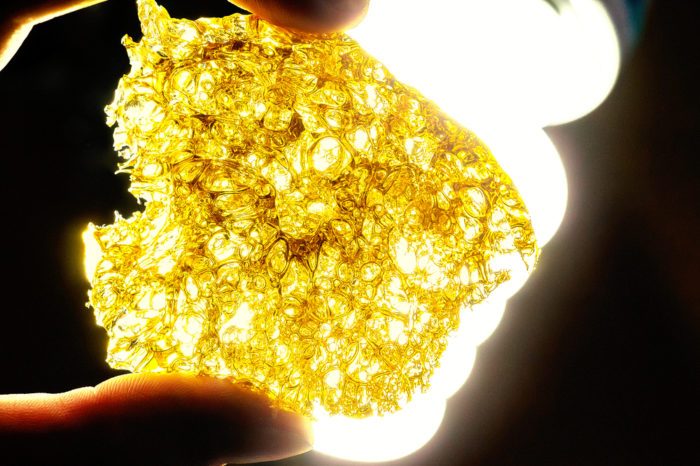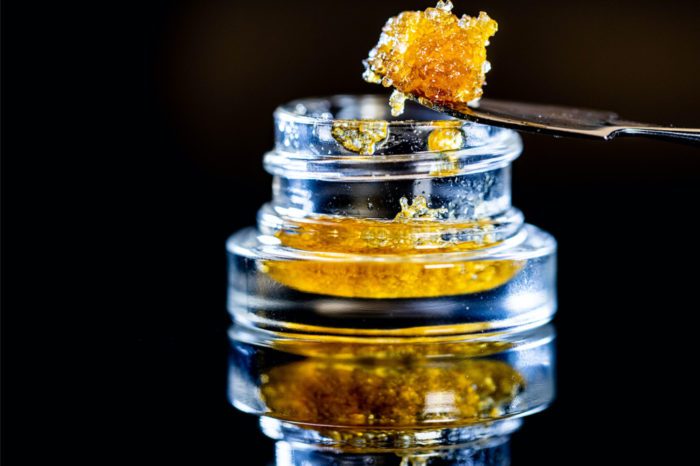Sugar wax is a strong-smelling, nectar-flavored, terpene-rich extract with a medicinal kick.
Sugar wax is a form of cannabis concentrate that boasts a rich and complex flavor profile. It comes in an extract, with a somewhat grainy texture. It is thick, viscous, and easily managed when compared to many other concentrates.
Sugar wax obtains its sugary consistency via an agitation process in the production phase. This process—known scientifically as nucleation—occurs as a result of the high terpene content in sugar wax. During the nucleation phase, the high quantities of terpenes in the oil act as a recrystallization agent, causing terpenes and cannabinoids to separate. This leads to a concentrate that’s moist, with a sugary texture. When processed correctly, this form of cannabis concentrate boasts maximum terpene content and heightened flavors along with high quantities of THC.
Why are Concentrates so Potent?
Sugar wax is highly-potent and often contains THC levels ranging between sixty and ninety percent. Of particular interest to medicinal patients is the fact that sugar wax retains much of the source material’s terpene content. Basically, it’s the presence of these terpenes that helps potentiate the medicinal effects of the already high quantities of THC present.
In general, cannabis concentrates are potent due to high levels of cannabinoids, typically THC or CBD.
Can I Make Sugar Wax?
Cannabis cultivars that have a high terpene content are best for making sugar wax, as these tend to hold water content. But, like any concentrate, potency and medicinal value are largely dependent on the quality of the source material.
The making of sugar wax usually involves a form of butane extraction, although other additional solvents, like ethanol, are common with certain vendors. The presence of butane means that sugar wax generally isn’t recommended as a DIY project for enthusiasts at home. Futher, butane is dangerous to work with, and without taking appropriate safety precautions into account, accidents are a real possibility. The blowing up kind of accident.
When the solvent strips the source flower of its cannabinoids and terpenes, whipping the extracted solution will cause nucleation to occur faster. This is what helps give the final product that waxy texture. Producers then place the sugar wax in a vacuum oven to precipitate the formation of the crystalline consistency. The resulting color of the wax can change significantly during this process. It depends on the exact solvents and the cultivar of cannabis used, and can range from a light golden tint to a deep, rich, amber.
It is not recommended that the average cannabis consumer attempt sugar wax DIY. The process requires moderate to high levels of expertise and proper equipment.
How do I use Sugar Wax?
Basically, patients can consume concentrates in several ways. The most common method of consumption is by dabbing on a portable vaporizer or dab rig. Dabbing has quickly become the most popular method of consuming many concentrates. It provides a clean method of intake, where consumers avoid inhaling any carcinogenic compounds associated with burning plant material.
Another common method of consumption is to sprinkle some onto the flower in a joint or a bowl. This will increase the strength of what you are smoking. It provides an extra-potent kick, and is often useful for patients who require higher than average doses to manage pain.
The Medicinal Value of Concentrates
Like many forms of cannabis concentrate, sugar wax is popular with medicinal patients who require higher therapeutic doses—whether that’s to treat chronic conditions or overcome existing tolerances. Further, it’s incredibly potent, and ideal for those who require intensive therapies due to the fast and effective relief it can provide.
Basically, the high THC content, coupled with the preservation of much of the original terpene content, makes sugar wax one of the more attractive concentrates for patients.
Many recreational consumers undervalue the presence of terpenes. But, these are what help modulate much of the medicinal effect of the plant. “Taming THC” a study published in the British Journal of Pharmacology (2011), explored in much greater detail the critical role that terpenes play in medicinal cannabis. The researchers stated that terpenes, “display unique therapeutic effects that may contribute meaningfully to the entourage effects of cannabis-based medicinal extracts.” And when it comes to enhancing medicinal benefits, they claimed: “that terpenoids with pain-relieving, anti-anxiety or sedative effects may supplement such activity, notably, caryophyllene, linalool, and myrcene.”[1]Russo E. B. (2011). Taming THC: potential cannabis synergy and phytocannabinoid-terpenoid entourage effects. British journal of pharmacology, 163(7), 1344–1364. … Continue reading
Concentrates are commonly used to overcome existing high tolerances in patients. Concentrates, like sugar wax, may also help treat conditions like chronic pain.
Where to Buy Sugar Wax
Like any concentrate, it’s always best to purchase it from a reputable source. This ensures that levels of pesticide and solvent residues meet the safety requirements stipulated by law.
Sugar wax is one of a variety of concentrates, each with its own unique properties. Some of the similarily-potent cannabis concentrates available include live resin, shatter, budder, and the terpene-rich HTFSE extracts. Each exhibits potent medicinal benefits that may suit some medicinal patients over others. Keep the source material for the extract high quality, and make sure solvent residues are purged sufficiently. The choice of concentrate often comes down to personal preference and the particular needs of the patient.
References





